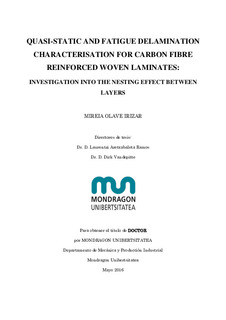Title
Quasi-static and fatigue delamination characterisation for carbon fibre reinforced woven laminates: investigation into the nesting effect between layersAuthor
Reading Date
2016-07-06Publication Date
2016Document type
Doctoral ThesisDoctoral ThesisLanguage
EnglishRights
© Mireia Olave IrizarAccess
Open accessPublisher’s version
https://doi.org/10.48764/ppyb-2935Publisher
Mondragon Unibertsitatea. Goi Eskola PoliteknikoaKeywords
Propiedades de materialesEnsayo de materiales
ODS 9 Industria, innovación e infraestructura
ODS 13 Acción por el clima
Abstract
Low weight is one of the most important design criteria to be considered during the selection of the material for different applications. Weight saving is necessary in the applications where the compo ... [+]
Low weight is one of the most important design criteria to be considered during the selection of the material for different applications. Weight saving is necessary in the applications where the components are in motion. Materials for transportation systems such as high-speed trains, automobiles, aircraft, or mobile components like wind turbine blades need to fulfil the strength requirement without increasing the component’s thickness and, consequently, weight. Accordingly, composite materials offer the advantage of providing a lightweight structure because of their low density but with a considerable increase in strength-to-weight ratio.
Under different load conditions, static and/or dynamic, the layers of the composite material may try to debound. This phenomenon is called delamination and it is a common damage mechanism that ends up in a loss of stiffness and strength. This is the reason why in order to prevent delamination damage in composite materials, the correct characterisation and modelling of the interlaminar fracture behaviour can play an important role in the design of composite parts. The initiation of a delamination does not mean that there is a catastrophic failure in the material. The delamination may not grow any further for the rest of its service life if the loading condition does not exceed a specified crack propagation limit. The design procedure must not only cover the static interlaminar strength calculation of the component, but also the dynamic interlaminar strength calculation, and be able to support maximum load levels and fatigue dynamic loads without total failure. Good knowledge of interlaminar fracture behaviour can facilitate reliable and efficient design criteria to prevent the final failure of the component.
Carbon fibre reinforced woven textile laminates are widely used in aeronautics, automotive or sport equipment applications due to their excellent performance and low weight. One of the reasons is that as the drapability of these textiles is high compared to unidirectional laminates, curved shapes can be manufactured easily. Due to the yarn alignment in orthotropic directions, woven structures show good in-plane mechanical behaviour, but low delamination resistance because of poor through-thickness properties. Many authors have seen in their experimental tests that fracture toughness and surface geometry can be affected because of textile structure geometry characteristics; the inner structure of the woven material has an impact on the delamination damage evolution in the laminate. The nesting effect, for example, which is the interaction between neighbouring layers of a textile composite laminate, can be strongly linked to the fracture surface geometry and the delamination behaviour.
In this work the internal structure geometry is linked to the static and dynamic fracture toughness values. The analysed properties are the nesting and the unit cell size effect. The most suitable test methods are proposed for measuring the static and fatigue fracture toughness values for the selected textile composite material. The conclusions show that fracture behaviour of the woven textile composite material changes depending on the internal structure. [-]
Collections
- Theses - Engineering [243]





















